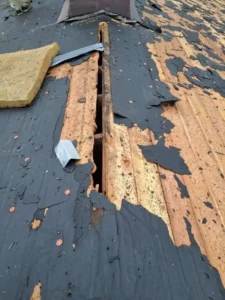A roof is the top covering of a building that provides protection against the elements, such as rain, snow, sunlight, temperature extremes, and wind. It is constructed using various materials and supports.
Are you confused about choosing between asphalt shingles and metal roofs? No worries! Indianapolis Roofing LLC has got a solution for you!

Table of Contents
ToggleRoof Essentials Explained
A roof is the top covering of a building, including all materials and constructions necessary to support it on the walls of the building or on uprights, providing protection against rain, snow, sunlight, extremes of temperature, and wind.
There are various types of roofs available, each with its own advantages and disadvantages. Some common roof designs include:
| Roof Design | Advantages |
| Hip | A hip roof has slopes on all sides, providing excellent stability and resistance to wind. |
| Gable | A gable roof features two sloping sides that meet at the top to form a ridge. It is a popular choice due to its simple design and effective water drainage. |
| Flat | A flat roof has an extremely low pitch and is almost horizontally level. It is often used in commercial buildings and can provide additional usable space. |
When considering roof materials, it is important to choose the one that suits your climate, budget, and aesthetic preferences. Common roofing materials include asphalt & fiberglass shingles, wood shingles & shakes, clay & concrete tile roofing, rubber roofing, and composite materials.
It is worth noting that the cheapest type of roof may not always be the most durable or suitable for your needs. It is recommended to consult professionals and consider long-term costs when making a decision.
Types Of Roof Materials
There are various types of roof materials that you can choose from when building or renovating a property. Here is an overview of some popular options:
1. Asphalt Shingles
Asphalt shingles are the most common type of roofing material used in residential properties. They are affordable, easy to install, and come in a wide range of colors and styles.
2. Metal Roofing
Metal roofs are becoming increasingly popular due to their durability, energy efficiency, and longevity. They are available in a variety of materials such as steel, aluminum, and copper.
3. Clay And Concrete Tiles
Clay and concrete tiles are known for their aesthetic appeal and durability. They are resistant to fire, rot, and insects, making them a great choice for homeowners looking for a long-lasting roof.
4. Green Roofing Options
Green roofing options, such as vegetative roofs or roof gardens, are gaining popularity as they provide numerous environmental benefits, including energy conservation and improved air quality.
Architectural Styles For Roofs
Gable roof design is characterized by two sloping sides that meet at the top to form a ridge. It is a popular choice for homeowners due to its simplicity and effectiveness in shedding water and snow. On the other hand, a hip roof has slopes on all sides, providing more stability and resistance to strong winds. This design is ideal for areas prone to hurricanes or cyclones.
A flat roof has an extremely low pitch and is almost horizontally level. It offers a modern and minimalist look to buildings. A skillion roof, also known as a shed roof, is a variation of a flat roof with a steeper slope on one side. This design is commonly used for sheds, garages, or modern-style homes.
Mansard roof design features a double-sloped roof with a steeper lower slope and a flatter upper slope. It allows for maximized living space in the attic. Gambrel roof, commonly seen in barns and farmhouses, has two different slopes on each side, creating more headroom and usable space on the upper floor.
Roof Installation Process
A roof is the top covering of a building, providing protection against various elements such as rain, snow, sunlight, temperature, and wind. The installation process of a roof involves several phases, starting with planning and design. During this phase, the type of roof design needs to be determined, including options such as hip, gable, and flat roofs. Each design has its own advantages, and the choice depends on the specific requirements of the building. Safety protocols on the job site are of utmost importance to ensure the well-being of the workers and the successful completion of the installation process. Following the planning and design phases, the step-by-step roof installation guide needs to be followed to ensure a proper and durable roof. It is crucial to select the appropriate roofing materials, such as asphalt shingles, clay tiles, or composite materials, depending on factors like durability, cost, and aesthetics.
Maintaining Your Roof
- Regularly inspect your roof for any signs of damage or wear and tear.
- Clean your gutters and downspouts to avoid clogs and water damage.
- Trim any overhanging branches or vegetation that can damage the roof.
- Check for any loose or missing shingles and replace them promptly.
- Clear away any debris, such as leaves or moss, that can accumulate on the roof.
- Look for cracked or curling shingles, as well as bald spots.
- Check for any signs of leaks, such as water stains on the ceiling.
- Inspect the flashing around chimneys, vents, and skylights for any damage.
- Examine the roof for any sagging or uneven areas.
| Material | Longevity |
| Asphalt shingles | 15-30 years |
| Metal roofing | 40-70 years |
| Clay or concrete tiles | 50-100 years |
| Wood shingles | 30-50 years |
Regular maintenance is key to ensuring the longevity of your roof. By following these seasonal tips and identifying any signs of wear and tear, you can address issues promptly and extend the lifespan of your roof. Each roofing material has its own expected longevity, so consider the lifespan when choosing the right material for your home.
Roof Repair Techniques
A roof is the top covering of a building, providing protection against various elements. There are some DIY fixes that you can try for minor damage. For example, if you notice a small leak, you can apply roofing cement to seal it. However, for more extensive damage or if you’re unsure about the repairs, it’s best to call a professional. They have the expertise and equipment to assess the damage and provide appropriate solutions. In some cases, a long-term repair may be needed to address the underlying issues and prevent future damage. It’s important to consider the type of roof, the materials used, and the severity of the damage when determining the most appropriate repair technique. Overall, ensuring a well-maintained roof is crucial for the safety and longevity of your building.
Technological Advancements In Roofing
With technological advancements in roofing, the way we protect our buildings has transformed. From innovative materials to smarter designs, roofs are now more durable, weather-resistant, and energy-efficient, ensuring long-lasting protection against rain, snow, sunlight, temperature extremes, and wind. Stay updated on the latest roofing technologies to enhance the performance and lifespan of your roof.
Solar Roofing Integration
With the increasing demand for sustainable energy solutions, solar roofing integration has emerged as a popular trend. Solar panels are now designed to seamlessly blend with the roof’s surface, making them a visually appealing and efficient choice. These advanced systems harness the power of the sun to generate electricity, reducing reliance on traditional energy sources and saving homeowners money on utility bills.
Innovative Insulation Materials
Insulation plays a crucial role in maintaining energy efficiency and temperature control in a building. Technological advancements in insulation materials have led to the development of more efficient and environmentally friendly options. Materials like aerogel and vacuum-insulated panels offer superior insulation properties, minimizing heat loss and reducing energy consumption. These innovative materials also contribute to a more sustainable and eco-friendly construction industry.
Smart Roofs And Future Trends
The integration of smart technologies in roofing systems is another exciting development in the industry. Smart roofs are equipped with sensors and monitoring systems that can detect leaks, temperature changes, and other issues in real-time. This allows for proactive maintenance and early detection of potential roof problems, saving costs on repairs and extending the lifespan of the roof. As technology continues to advance, we can expect further innovations in the roofing industry, such as self-healing materials and energy-generating roof tiles.
Environmental Impact Of Roof Choices
The environmental impact of roof choices can vary depending on the materials used. Choosing sustainable and eco-friendly options like green roofs or solar panels can reduce energy consumption and promote sustainability. Proper insulation and ventilation can also contribute to energy efficiency and minimize environmental impact.
Energy-efficient Designs And Materials
When considering the environmental impact of roof choices, it is important to focus on energy-efficient designs and materials. Energy-efficient designs can help reduce the need for artificial lighting and heating, lowering energy consumption. Opting for materials with high thermal insulation properties, such as cool roofs or green roofs, can also contribute to energy efficiency by reducing heat transfer into the building. Another aspect to consider is roofing and rainwater collection. Collecting rainwater from roofs can help conserve water resources and lower the dependency on municipal water supply. Lastly, sustainable practices in the roofing industry play a crucial role in reducing environmental impact. This includes using recycled or sustainable materials and implementing roof recycling programs to minimize waste going to landfills. By making conscious choices, we can create roofs that are not only durable and functional but also environmentally responsible.
Sources:
- Roof – Britannica
- Roofing – The Home Depot
- Roof Definition & Meaning – Merriam-Webster
- Three Common Roof Designs and Their Advantages – ABCO Roofing
- What Type of Roof is Cheapest? – Energy Shield of New Hampshire
Conclusion
A roof is an essential part of any building, providing protection against the elements such as rain, sunlight, and wind. It serves as the top covering, supported by the walls or uprights of the structure. The type of roof design can vary, including hip, gable, or flat roofs, each with its own advantages.
Choosing the right roofing material is crucial in terms of cost and durability. Whether you’re looking to install a new roof or replace an existing roof, it’s important to consider factors such as budget and climate. Contact the best roofing contractor in Indianapolis to make an informed decision that suits your needs.






